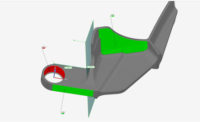First Article Inspection: It’s the Standard

Ever since the revolution of Henry Ford’s assembly line, it has been possible to produce identical complex products in drastically less time. It was the inception of mass production as we know it today.
Over the years, as these complex products became more intricate, it became more difficult to reach the idea of “identical.” Increasingly smaller components, the addition of sensitive components like electronics, and decreasing tolerances for manufacturing specifications were helped along by manufacturing technologies such as computer-aided drafting that have stretched all the way to automation and robots on the shop floor.
The concern that continues to this day is how to bring this all together to provide an unimpeachable manufacturing process resulting in an unquestionably superior product. The solution that continues to this day is first article inspection.
First article inspection, or FAI, is described by verification, documentation, and confirmation:
- Verification: Initially, the manufacturer verifies that the first part created matches the specifications supplied by the customer. Machine shops work with electronic data for the machine tools and drawing documentation that specifies the size, shape, and dimensions of the product. Quality inspections and FAI inspections are performed against a customer-supplied, 2-dimensional (3-dimensional, in some cases) print of the part design, that often contains extra information about tolerances for specific features of the part.
- Documentation: The inspection of the first article will be documented for two reasons. First, to ensure that the production runs of the part match the first article, the manufacturer will rely on the first article inspection report for periodic audits to verify conformance. Second, parts that are built for certain industries, such as aerospace, must have their first article inspections documented in conformance to set standards.
- Confirmation: The first article inspection verifies that the part matches the initial specifications, and opens up additional communications with the customer. For instance, the machine shop will use a first article inspection report to confirm the design specifications of the part or alter those specifications as needed. In these situations, the FAI surpasses a simple pass or fail report, becoming an instrument for refining the specifications to best fit the customer’s needs.
As alluded to in the “documentation” item, and because it is such a viable solution, FAI also is a paramount part of many standards, ones governing the production of some of the most important, most quality-intensive products manufactured, such as aerospace components and medical devices.
Because it is required as part of a standard, you may say that’s the only reason manufacturers follow it. But unlike a child asking, “Why?” and an adult answering, “Because I said so,” FAI is much more than that. And its simplicity and utility is reiterated in those standards, for instance, AS9100, the standard covering aviation, space, and defense. The article governing FAI reads as follows:
In the AS&D industry, when a new or revised part is produced for the first time, it must be verified to ensure all requirements have been met. Many organizations meet this requirement by complying with the AS9102B First Article Inspection (FAI) standard (sometimes referred to as production process verification). FAI involves selecting one part from the first batch/lot produced and verifying that the following major elements meet customers’ customer requirements:
- Production processes being (or to be) used
- Documentation
- Tooling
The production part verification process has been updated recently to include advances like verification against digital specifications like multi-dimensional computer assisted drawing (CAD) files in the AS9102B update.
It additionally states:
- FAI can also be helpful in a corrective action process when a company is trying to isolate the cause of a nonconformity in their production process.
- FAI documentation offers information about what companies need to know in order to address/change whatever could have caused the issue.
- Regular implementation of FAI helps companies maintain and improve their production processes over time.
How about a medical device example? In the blog, “How First Article Inspection Helps Limit Defects in Mass Production,” author Maegan Burkhart asks us to, “imagine you’re manufacturing pacemakers in a factory in China. You conduct a product inspection of the first trial order once the factory has finished 80 percent of the goods. But when you receive the inspection report, you find there are major issues with the internal parts used in production.
Your supplier has locally sourced several vital components, which they were supposed to import from suppliers in Japan. And the lithium battery doesn’t meet the capacity requirement your supplier agreed to when you placed the order. Most of your order is now unsellable. How could you have prevented this?”
That’s right, first article inspection.
Looking for a reprint of this article?
From high-res PDFs to custom plaques, order your copy today!






